Actinopterygii (ray-finned fishes) >
Syngnathiformes (Pipefishes and seahorses) >
Syngnathidae (Pipefishes and seahorses) > Syngnathinae
Etymology: Cosmocampus: Greek, kosmos = order, organization + Greek, kampe = bent, curvature (Ref. 45335).
Environment / Climate / Range
Ecology
Marine; benthopelagic; depth range 2 - 45 m (Ref. 90102). Tropical, preferred ?
Indo-West Pacific: Kuwait to Ko Samui Island, Gulf of Thailand.
Size / Weight / Age
Maturity: Lm ? range ? - ? cm
Max length : 7.2 cm SL male/unsexed; (Ref. 5316)
Short description
Morphology | Morphometrics
Some specimens have been taken in surface tow nets and with nightlight and dipnets; others taken in a dredge sample (Ref. 5316). Ovoviviparous (Ref. 205). The male carries the eggs in a brood pouch which is found under the tail (Ref. 205). Found in sand, mud and coral bottoms in 2-45 m (Ref 90102).
Life cycle and mating behavior
Maturity | Reproduction | Spawning | Eggs | Fecundity | Larvae
Male carries the eggs in a brood pouch (Ref. 205).
Dawson, C.E., 1985. Indo-Pacific pipefishes (Red Sea to the Americas). The Gulf Coast Research Laboratory Ocean Springs, Mississippi, USA. (Ref. 5316)
IUCN Red List Status (Ref. 115185)
CITES (Ref. 94142)
Not Evaluated
Threat to humans
Harmless
Human uses
More information
Age/SizeGrowthLength-weightLength-lengthLength-frequenciesMorphometricsMorphologyLarvaeLarval dynamicsRecruitmentAbundance
ReferencesAquacultureAquaculture profileStrainsGeneticsAllele frequenciesHeritabilityDiseasesProcessingMass conversion
Tools
Special reports
Download XML
Internet sources
